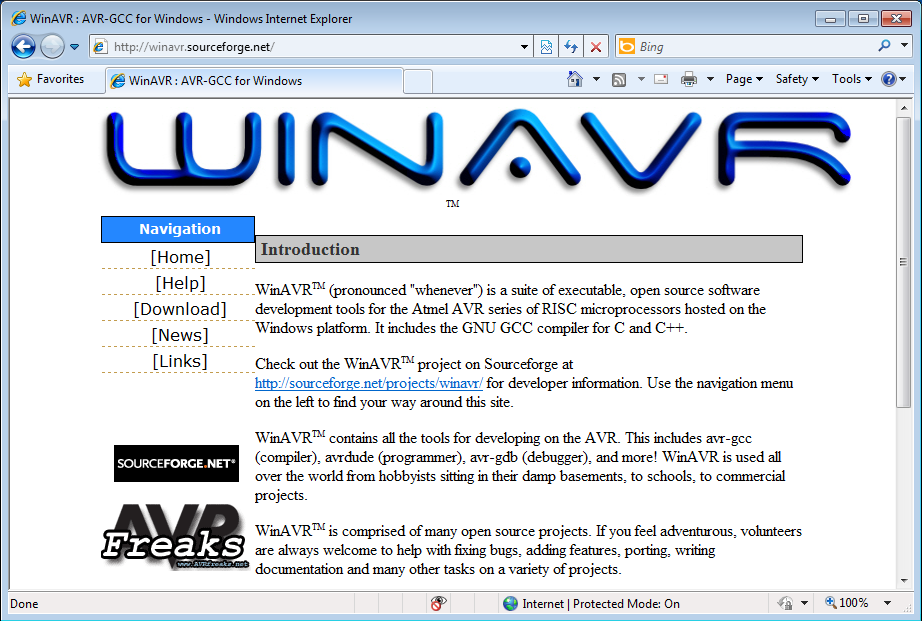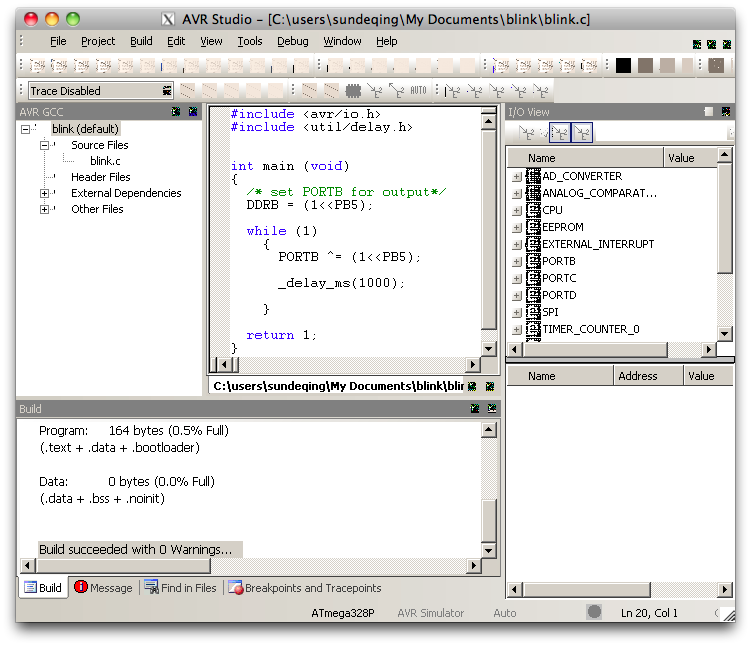CrossPack for AVR® Development CrossPack is a development environment for Atmel’s AVR® microcontrollers running on Apple’s Mac OS X, similar to AVR Studio on Windows. It consists of the GNU compiler suite, a C library for the AVR, the AVRDUDE uploader and several other useful tools.
Windows users have been enjoying various awesome tools to help with their AVR development process like the Atmel Studio, Codevision AVR, WinAVR, IAR Embedded Workbench, etc. This doesn’t mean that Mac and Linux users are at any unfair advantage. The avr-gcc toolchain supports Unix based OS like Linux and Mac OS X inherently.
In this post I will show how to install the avr-gcc toolchain and avrdude on Mac OS X and Linux. If you are using a Mac and want to save the trouble of going through these steps, simply install CrossPack for AVR Development and follow the instructions in the manual. I might go over it sometime in future though.
However if you really want to learn how to set up a cross-compiler, write Makefiles and use command line tools to get things done, I highly recommend doing the following steps. And trust me, they are pretty straightforward.
Step 1: Install Homebrew (Mac OS X only)
Step 2: Install avr-gcc toolchain
Step 3: Install avrdude
Step 4: Test the toolchain
Busy and just want to get s#!t done? Read the summary!
This step is not required for Linux users since almost all Linux distribution comes with a package manager.
Homebrew is the new super-awesome package manager for Mac OS X. Install it by typing (or pasting) the following in terminal:
Mac OS X
First tap the repository:
Then install the latest version of avr-libc (version 4.9.2 at the time of writing):
Uninstall visual studio for mac. Uninstalling Visual Studio for Mac.; 4 minutes to read Contributors. All; In this article. There are a number of Xamarin products that enable cross-platform application development, including stand-alone apps like Visual Studio for Mac. How can the answer be improved?
This will pull avr-binutils and avr-gcc along with it as well. The second steps takes a little while to install everything, so go get yourself some tea in the meantime.
The Homebrew repository doesn’t has the avr-gdb formulae yet. If you need the avr-gdb debugger, go for the AVR CrossPack.
Linux
The following steps are for Debian/Ubuntu Linux. For other Linux distributions, please install read this.

It is usually a good idea to update all the packages you already have installed.
Then install the required packages.
You can also install gdb-avr is you like. It is useful for in-system debugging/emulation.
Once done, type avr- in the terminal and press tab twice (do not hit enter). You should be able to see all the tools installed for you.
AVR-GCC is a toolchain that will help you with the software development process, but doesn’t do anything about burning the final executable (the hex file) to the microcontroller. For that we need to install AVR Downloader UploaDEr (avrdude).
Mac OS X
We will again use Homebrew to install it.
Linux
The following steps are for Debian/Ubuntu Linux. For other Linux distributions, please install read this.
This should be pretty quick. Once installed, type avrdude -v in the terminal to check if it is installed properly.
That’s all we need for now. Let’s test whether it works or not. I have used the LED blinking code called led.c for ATmega32 for demonstration. Refer to this post to understand what it does.
Once the tools are installed no matter how, everything from here remains the same for both Mac OS X and Linux.
Avr Studio For Mac
Assuming the name of the file is led.c, type the following in the terminal and check if the led.hex file is generated or not. The code should compile without any errors. Don’t worry if you don’t understand what the commands do or mean, we will discuss about them in detail in the next post.
Type cat led.hex in the terminal and see if the hex file is generated. If you see something like in the image below, you’re all set! :)
We will need the hardware to test avrdude, so let’s just skip it for now. In my next post, I’ll show you how you can use the avrdude to transfer the hex file generated above to run on an actual hardware. If you have any questions, please ask them below. Thank you.
Here’s what you gotta do on Mac OS X:
And here’s what you gotta do on Debian/Ubuntu Linux:
For all other Linux distributions, read this.
Thanks for reading! Subscribe and stay updated!
Written by Mayank Prasad
Last updated on June 14, 2015
Related
Some AVR code that I wrote for my ATMEL ATMega32 based board. Code is in Assembly and C.
Include files
The Assembly folder contains include folder that has the .inc files for all supported AVRs by the AVR assembler. They can be found in any release of AVR Studio. This one was taken from AVR Studio 5.
C Templates
Avr Studio 4 Mac Download
Windows
Just use Atmel Studio. That's good enough
Linux
Sorry, nothing for that yet
Mac OS X
You should be using X-AVR. Simply follow these instructions and get it working. It's worth it.
Assembler setup
Mac OS X Lion 10.7.3+
Install Mac Homebrew or Macports. I prefer Homebrew, it's much cleaner.
Recording studio software for mac. A complete studio for your Mac. Logic Pro X turns your Mac into a professional recording studio able to handle even the most demanding projects. Capture your compositions and performances — from tracking a live band to a solo software-instrument session — and flow them into your songs. Recording studio software, free download - Mac Screen Recorder Studio, WireTap Studio, DAZ Studio, and many more programs. Here, we've rounded up the best free recording software for several operating systems, including Windows, MacOS, and Linux.
Windows XP+
If you're an open source maniac and do things from ground up then you can download the AVR Assembler from Sourceforge
If you're not mental about it, you can just download ATMEL Studio and get things done.

NOTE: for AVR Studio you need to remove the .INCLUDE line, it automatically does that inclusion for you.
Linux
If you have a Debian based linux box you can just download the package from aptitude

Otherwise you can build it. You need to grab the source and build it yourself. It's not that hard.
Assembler tutorial
I haven't got around to writing my own tutorials yet, but here's a guide that can help you with that. It's by ATMEL. You can find it here
Simulator
It's good to have a simulator to learn what is actually going to happen when your code is executed. So for that, we have certain tools.
Mac OS X 10.6+
MacSimAVR this is an alpha release and will be paid soon.
SimulAVR you can find more about this here
Windows XP+
AVR Studio all the way. That's why I use Windows, for controller programming and games. Otherwise Linux has everything I will ever need.
Linux
You need to find Simulavr using your package manager and install it. It's command line as far as I remember.